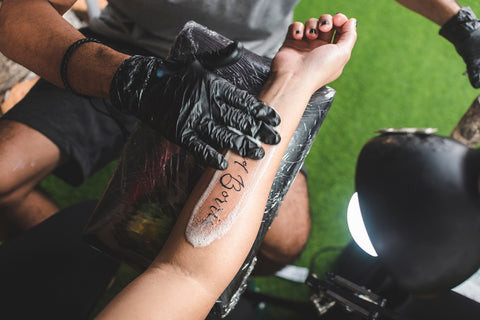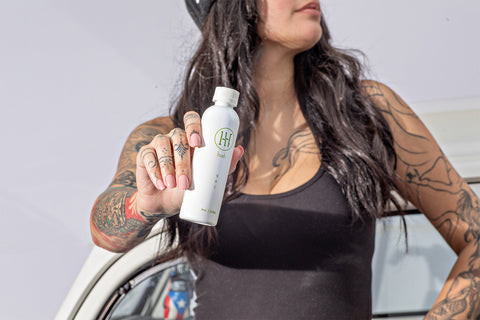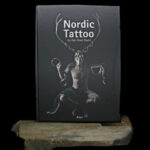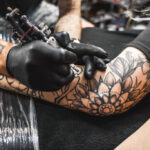Are you considering a forearm tattoo and wondering about the pain factor? Many people considering body art often ask, “Do Tattoos On The Forearm Hurt?” At tattooat.com, we understand that getting a tattoo is a big decision, and pain is a common concern. We’re here to provide you with all the details on tattoo pain, forearm placement, and pain management, ensuring a comfortable and informed experience. Learn about the pain levels, popular designs, and aftercare tips for your next tattoo.
1. Understanding Forearm Tattoo Pain
While pain is subjective, generally, forearm tattoos are considered less painful compared to other body parts. The area boasts fewer bones and nerve endings, but more muscle and flesh. However, individual pain tolerance varies, and what one person finds manageable, another may find more intense.
At tattooat.com, we believe that pain shouldn’t deter you from getting the tattoo you desire. That’s why we offer comprehensive information and solutions to help you manage discomfort, no matter where you choose to get inked.
1.1. Outer Forearm Pain
The outer forearm is often cited as one of the least painful spots for a tattoo. With ample flesh and fewer nerve endings, this area offers a more comfortable tattooing experience.
However, the elbow area on the outer forearm can be more sensitive due to its bony nature and thinner skin. Don’t let that deter you! With proper preparation, including pain-numbing products like those available at tattooat.com, you can still achieve your dream elbow tattoo.
1.2. Inner Forearm Pain
The inner forearm tends to be slightly more sensitive than the outer forearm due to a higher concentration of nerve endings. However, it’s still considered a relatively low-pain area for tattoos.
Similar to the outer forearm, the area around the inner elbow can be more sensitive due to thinner skin and more nerve endings. Additionally, this area experiences more movement, which may slightly prolong the healing process.
1.3. Sleeve Tattoo Pain
A sleeve tattoo, which covers the entire arm, including both the front and back, can be more painful than smaller tattoos. This is simply due to the larger area being tattooed and the longer duration of the sessions. A full sleeve tattoo encompasses the bicep and forearm, while a partial sleeve covers only one of these areas.
Despite the potential for increased pain, sleeve tattoos offer stunning artistic possibilities. The ability to heal between sessions makes the process more manageable. With proper pain management strategies, a sleeve tattoo can be an achievable and rewarding experience.
2. Popular Forearm Tattoo Ideas
 Forearm tattoo inspiration, featuring a detailed floral design wrapping around the arm
Forearm tattoo inspiration, featuring a detailed floral design wrapping around the arm
Choosing a design is a fun part of the tattoo process. Forearm tattoos provide ample space for various designs, ranging from meaningful symbols to artistic expressions.
At tattooat.com, we provide a vast collection of tattoo ideas to inspire you. You can collaborate with an artist to create a unique design or discover artists posting designs for claim.
Smaller tattoos are ideal for those who prefer something less detailed, while partial or full sleeves allow for piecing together multiple designs over time. Whether you opt for a popular design or a unique creation, a tattoo artist can help you achieve your vision.
2.1. Quote Tattoos
Quotes are a popular choice for forearm tattoos. Small, thin quotes in black ink offer a subtle yet meaningful design.
For a bolder statement, you can opt for a larger, more prominent quote. Quote tattoos can even be designed as armbands, wrapping around the forearm for a unique look.
2.2. Armband Tattoos
Armband tattoos are a versatile option that wraps around the forearm or wrist. They can range from geometric shapes and designs to tribal patterns, dot work, or tree tattoos.
Whether you prefer a minimalist geometric design or a complex web of branches and vines, a tattoo artist can create the perfect armband tattoo for you.
2.3. Flower Tattoos
Flower tattoos are incredibly versatile, offering a wide range of shapes, sizes, and levels of detail. Even simple designs like a rose tattoo can be customized with various styles, such as watercolor red roses or minimalist black rose outlines.
Discussing your options with your artist will help you create a flower tattoo that reflects your personal style and preferences.
2.4. Smaller Designs
Numerous smaller designs can adorn your forearm. Popular options include an arrow running the length of the forearm or a vertical tree.
Regardless of the size you prefer, a skilled tattoo artist can create a design that you’ll love.
2.5. Cover-Up Tattoos
 Forearm tattoo inspiration, featuring a detailed floral design wrapping around the arm
Forearm tattoo inspiration, featuring a detailed floral design wrapping around the arm
Mistakes happen, and sometimes tattoos no longer resonate with us. Whether it’s a dragon tattoo, a wolf tattoo, or an ex-lover’s name, cover-up tattoos offer a solution.
Instead of undergoing multiple painful tattoo removal sessions, a skilled tattoo artist can create a cover-up design that transforms your unwanted tattoo into a piece of art you’ll love.
3. Preparing for Your Forearm Tattoo
Proper preparation is key to a long-lasting, pain-free tattoo. Taking the necessary steps before, during, and after your session ensures your tattoo remains vibrant and healthy for years to come.
At tattooat.com, we offer a range of preparation products to help you get ready for your session.
3.1. Clean and Shaven Skin
Before your tattoo session, ensure the area is clean and free of hair or stubble. Shave the area smoothly, even if the hair is thin.
After shaving, clean the area thoroughly to remove sweat and dirt. Avoid getting tattooed after a sweaty gym session. Instead, take a shower and use a tattoo-specific cleanser. Our CBD Foam Soap is designed to soothe any discomfort during the session.
This foaming soap contains a soothing blend of botanicals like aloe leaf extract, chamomile extract, green tea extract, and calendula extract, combined with CBD extract for natural hydration and discomfort relief.
3.2. Relaxation, Satiation, and Hydration
Before your tattoo, ensure you’re well-fed and hydrated. Especially for longer sleeve tattoos or larger pieces, eat a full meal beforehand.
Needles can cause dizziness, and an empty stomach exacerbates this. A satisfying snack before your session can make a significant difference. Hydration is also essential for healthy skin, which is crucial for tattoo healing.
Avoid caffeinated drinks before your session and opt for water instead. Get a good night’s sleep and wear comfortable clothing to maximize relaxation during the tattooing process.
4. Taking Care of Your Skin During the Tattooing Process
The tattoo session is where the magic happens, but it can also be a source of pain for many.
Using a numbing agent like our Numbing Gel or Numbing Cream, you can relax while your artist works. These products minimize discomfort, allowing you to enjoy the experience.
4.1. Numbing Gel
Our water-based Numbing Gel contains lidocaine to effectively block nerve endings and reduce pain.
This fragrance-free gel eliminates flinching and anticipation, allowing you to focus on the art being created. The formula also includes soothing and supportive ingredients like green tea, chamomile, calendula, and aloe leaf extracts.
Menthol provides a cooling sensation, offering additional relief for irritated skin. Apply a thick layer of numbing gel an hour before your session, allowing ample time for the lidocaine to take effect.
To prevent mess, you can wrap your forearm in plastic wrap while the gel absorbs into your skin.
4.2. Numbing Cream
Our Numbing Cream offers the same pain-relieving benefits as our gel but is ideal for sensitive skin. This topical anesthetic also utilizes lidocaine to minimize pain.
The main difference between the cream and gel is the absence of menthol. While some people enjoy the cooling sensation of menthol, others may find it irritating. Both products are paraben-free, making them suitable for a variety of skin types.
5. Forearm Tattoo Aftercare
 Close-up of a freshly tattooed forearm, showcasing the initial stages of the healing process
Close-up of a freshly tattooed forearm, showcasing the initial stages of the healing process
Proper aftercare is crucial for preventing fading and infection. Follow your tattoo artist’s advice and use aftercare products. At tattooat.com we provide a range of aftercare products for a smooth healing process.
5.1. Keeping Your Tattoo Clean
Keeping your tattoo clean prevents bacteria from entering as it heals. New tattoos are essentially open wounds, so maintaining cleanliness is essential.
Use our CBD Foam Soap, designed specifically for tattoos, to protect your new ink from harmful bacteria. Our soap contains botanicals with soothing and cleansing properties and fatty acids to support your body’s natural healing process.
The 100 mg of organic CBD in our soap is non-psychoactive and THC-free, offering soothing and hydrating benefits.
5.2. Soothing Relief
For a new tattoo that’s itchy and irritated, use our Healing Spray. This numbing spray contains lidocaine to soothe your tattoo, preventing scratching and potential infection.
Follow the spray with our Healing Balm to soothe itchiness and irritation. This CBD cream is ultra-hydrating, containing shea and mango seed butter to moisturize your skin and triglycerides to help retain moisture. Our cream will help your new and old tattoos look vibrant and feel great with a blend of brightening oils.
5.3. Sunscreen Protection
If you’re getting a forearm tattoo in the summer, when you’re likely to wear short sleeves and spend time in the sun, consider postponing your tattoo until winter. Alternatively, be prepared to wear long sleeves for a few weeks until your tattoo heals.
Sunburns are detrimental to new tattoos, potentially disturbing the ink and requiring touch-ups. Severe sunburns can even lead to infection or blisters. Covering up is the safest option.
After your tattoo has fully healed, apply sunscreen with zinc oxide if you plan to expose your tattoo to the sun for extended periods. This protects against fading, bleeding, and sunburn.
6. Understanding Google E-E-A-T and Tattoo Expertise
At tattooat.com, we adhere to Google’s E-E-A-T (Experience, Expertise, Authoritativeness, and Trustworthiness) guidelines, ensuring we provide reliable and accurate information. As experts in the tattoo industry, we understand the importance of providing well-researched, trustworthy content that addresses your concerns and interests. Our commitment to these standards ensures that you receive the best possible guidance on your tattoo journey.
Our team includes experienced tattoo artists, dermatologists, and industry researchers who collaborate to produce content that is both informative and reliable. We continuously update our articles with the latest findings and best practices in the tattoo industry, ensuring you always have access to the most current information. By adhering to E-E-A-T, tattooat.com strives to be your go-to source for all things tattoo-related, building a community of informed and satisfied tattoo enthusiasts.
7. Addressing Your Concerns: A Comprehensive FAQ
To further assist you in making informed decisions about forearm tattoos, we’ve compiled a list of frequently asked questions:
| Question | Answer |
|---|---|
| Do forearm tattoos hurt a lot? | Forearm tattoos are generally considered less painful than other areas due to fewer nerve endings and more muscle. However, pain tolerance varies. |
| Which part of the forearm is most painful? | The inner forearm and areas around the elbow tend to be more sensitive due to thinner skin and a higher concentration of nerve endings. |
| How can I reduce pain during a tattoo? | Use topical numbing creams or gels, stay hydrated, eat before your session, and relax. |
| What are popular forearm tattoo designs? | Quotes, armband tattoos, flower tattoos, and smaller designs are all popular choices. |
| How do I prepare for a forearm tattoo? | Clean and shave the area, stay hydrated, eat a meal, and avoid caffeine. |
| What aftercare is needed for a tattoo? | Keep the tattoo clean, use soothing balms, and protect it from the sun. |
| Can I cover up an old tattoo on my forearm? | Yes, tattoo artists can create amazing cover-up designs to transform unwanted tattoos. |
| Is it safe to get a tattoo on my forearm? | As long as you go to a reputable artist and follow aftercare instructions, forearm tattoos are generally safe. |
| How long does a forearm tattoo take to heal? | Forearm tattoos typically take 2-4 weeks to heal, but this can vary depending on individual factors and tattoo size. |
| Can I use sunscreen on my forearm tattoo? | Yes, after your tattoo is fully healed, use sunscreen to prevent fading and damage from the sun. |
8. Call to Action: Explore Tattoo Ideas at Tattooat.com
Forearm tattoos are a popular choice for their visibility and relatively low pain levels.
At tattooat.com, we believe that getting a tattoo should be an enjoyable experience. We offer a variety of resources to help you prepare for your session, manage pain, and care for your tattoo afterward.
Explore our website, tattooat.com, to discover a wealth of design inspiration, find talented artists, and learn more about the world of tattoos. Whether you’re a first-timer or a seasoned tattoo enthusiast, we’re here to support you on your journey.
Address: 1825 SW Broadway, Portland, OR 97201, United States
Phone: +1 (503) 725-3000
Website: tattooat.com

